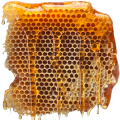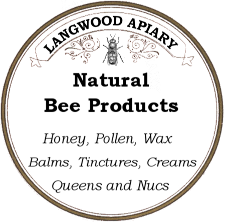 In the history of each nation, you can find information about the therapeutic and prophylactic use of honey. In Egypt, 3,500 years ago, in a book about the preparation of medicines for all parts of the (human) body, there are many recipes that include honey. In the ancient Chinese manuscript “Description of Plants and Herbs of the God of Fertility” honey is given the following characteristic: “Honey heals internal organs, gives strength, and reduces heat. It strengthens the will, gives lightness to the body, preserves youth, and prolongs the years of life”. The old Indian “Book of Life” states that one can only prolong human life with elixirs and diet, including honey and milk. And in the book “The Drink of Immortality” there are indications that honey is the important part of the medicine for strengthening organism. Ancient scholars and physicians of Rome and Greece (Pythagoras, Aristotle, Hippocrates, Dioscorides, Homer, and Galen) wrote about the high healing properties of honey. The philosopher Democritus believed that honey had rejuvenating properties. Avicenna in the book “The Canon of Medicine” gives dozens of recipes, which included honey and wax; for people over 45, he recommended the systematic use of honey and walnuts.
In the history of each nation, you can find information about the therapeutic and prophylactic use of honey. In Egypt, 3,500 years ago, in a book about the preparation of medicines for all parts of the (human) body, there are many recipes that include honey. In the ancient Chinese manuscript “Description of Plants and Herbs of the God of Fertility” honey is given the following characteristic: “Honey heals internal organs, gives strength, and reduces heat. It strengthens the will, gives lightness to the body, preserves youth, and prolongs the years of life”. The old Indian “Book of Life” states that one can only prolong human life with elixirs and diet, including honey and milk. And in the book “The Drink of Immortality” there are indications that honey is the important part of the medicine for strengthening organism. Ancient scholars and physicians of Rome and Greece (Pythagoras, Aristotle, Hippocrates, Dioscorides, Homer, and Galen) wrote about the high healing properties of honey. The philosopher Democritus believed that honey had rejuvenating properties. Avicenna in the book “The Canon of Medicine” gives dozens of recipes, which included honey and wax; for people over 45, he recommended the systematic use of honey and walnuts.
As a therapeutic product honey is widely used in traditional medicine, it is recognized by official medicine in all countries of the world and is famous as a universal energy product and a wonderful pharmacological agent. It has tonic, antimicrobial, anti-toxic, anti-inflammatory, sedative properties and is able to restore impaired metabolic processes, restore the body’s immunological reactivity, increase its resistance to endogenous and exogenous intoxication, the effects of many environmental factors, including the effect of radiation. The use of honey as a therapeutic and prophylactic agent has following advantages:
- easy availability and relatively cheap
- can be assigned to almost every patient, at any age;
- it is used with pleasure by both children and adults;
- does not irritate the gastrointestinal tract and is absorbed easily and quickly;
- excessive accumulation of honey in the blood is easily removed through the kidneys, without irritating them;
- even with prolonged use honey does not cause any complications when taken according to the prescribed dose;
Honey can be used as an independent remedy in the treatment of diseases with a mild course or as an adjunct in the treatment of moderate and severe diseases in combination with other pharmacological agents. Honey can be an alternative remedy when a patient is intolerant to pharmacological medications or has a negative attitude towards them. Honey is used as a therapeutic or prophylactic agent:
- in the form of an aerosol
- for preparation of a bath with honey
Honey can be used as whole or diluted with water, alone or combined with other beekeeping products, medicinal plants and substances.
Honey is recommended to all healthy people who are or were placed in extreme situations in conditions of high psycho-emotional and physical exertion. It is included in the diet of athletes to increase endurance; it is recommended to people who have been exposed to toxic environment. Honey is especially good for children and adolescents in the period of enhanced growth, as well as for women during pregnancy and lactation.
Honey as a strengthening health agent is recommended for almost all diseases. It is used in preparation for surgery and after it, for the rapid recovery of the patient’s strength and for stimulation and regeneration of damaged tissues. Honey is very important for children and adolescents with insufficient physical development and chronic infections (chronic tonsillitis, sinusitis, bronchitis). It contributes to the normalization of impaired functions of many organs and systems – the central nervous system, circulatory system, blood formation, gastrointestinal tract, liver, kidneys, and immune system.
The antimicrobial and anti-inflammatory properties of honey are used in the treatment of skin, dental, otolaryngological, gynecological diseases, diseases of the respiratory tract, gastrointestinal tract, stomach, liver, incised and purulent wounds, abscesses, burns, eye diseases. From ancient times honey is used as a universal anti-toxic agent. It is able to excrete toxic substances from the body in case of infectious and somatic diseases, tobacco, alcohol, industrial intoxication and poisoning, during treatment with medicines.
Honey has a special use in gerontology and geriatrics; it slows aging and contributes to longevity (for e.g. beekeepers). It speeds up tissue regeneration, restores damaged skin, bone and joint elements, and improves metabolic processes in the myocardium, brain and liver. Honey is recommended as a mild sedative for severe irritability, headache, and depression, for treatment of functional diseases of the central nervous system, vascular dystonia, menopause, functional cardiomyopathy. At the same time honey should not be considered as a pharmacological panacea for all diseases, in no way it can replace antibiotics with acute infections or as the only means, for example, in case of liver disease or prevention of old age.
The therapeutic daily dose of honey and the duration of the course depend on the nature of the patient’s disease, the individual tolerance to bee products and the effectiveness of treatment. For prevention and treatment of most diseases, the daily dose for adults is 60-120 g, divided into 3-4 doses. It is better to take honey 1.5-2 hours before meals or 3 hours after meals. This reduces the effect of gastric juice on the biologically active components of honey.
The optimal duration of honey treatment is 1-2 months. However, with good tolerance and compliance with the daily dose and rules for taking honey, it can be consumed for months and years, as beekeepers do. To avoid side effects during treatment with honey, you must observe the following rules:
- exclude the use of other refined carbohydrates (sugar, candy, jam, sweet drinks);
- control your weight;
- periodically check blood sugar, especially for overweight people and elderly;
- do not exceed the daily dose;
- if there are signs of intolerance to honey, stop taking it and consult a doctor.
For medicinal purposes, it is better to use liquid honey. However, in the autumn and winter time it is almost impossible. Therefore, do not pay attention to crystallization. If the crystallization is large and honey is dense, then it must be dissolved in water or milk. For diseases of the oral cavity, sinuses, it is better to use crystallized honey because it slowly melts in the mouth and lasts longer in it, causing a local therapeutic effect.
Taking honey inside might be accompanied by unpleasant sensations: burning in the mouth, sore throat, burning along the esophagus, especially in the cardiac stomach, a feeling of heaviness in the stomach. These sensations depend on the type of honey and on the sensitivity of the mucous membrane during its inflammation. In such situations it is necessary to reduce the concentration of honey and take it diluted in 0.5 cup of warm boiled water or milk.
Patients with stomach disease with high acidity before taking honey should drink 1/3 cup of warm water with the addition of 0.5 teaspoon of baking soda. It neutralizes hydrochloride acid, preserving the antimicrobial and anti-inflammatory effects of honey. In case of the stomach diseases, it is preferable to use dark varieties of honey, which have a certain potential alkalinity.
Having decided to take honey inside, it is advisable to conduct a test for the general as well as local tolerance to the honey. Take a teaspoon of honey in your mouth, hold for a few minutes, swallowing in small portions. In case of discomfort honey should be diluted or replaced with a different variety of honey.
Honey can be introduced into the body using galvanic current (electrophoresis) and ultrasound (phonophoresis). Electrophoresis is indicated for rhinitis, sinusitis, bronchitis, bronchial asthma, genital trichomoniasis, cervical erosion. Phonophoresis is used in the treatment of respiratory diseases and genital diseases.
As local and topical medication, honey can be used as whole, or in the form of a 20-40% solution, or in the form of an aerosol.
For therapeutic purposes, honey causes a greater effect when used in combination with other beekeeping products – propolis, pollen, royal jelly.
Matching Medical Treatment with Variety of Honey
According to modern concepts, the use of honey as a therapeutic agent should be matched with its targeted action. Based on the traditional medicine and numerous clinical observations, the doctor recommends to the patient the sort of honey from which the greatest clinical effect can be obtained. When acquiring the right variety of honey, the consumer is usually guided by the advice of the seller (beekeeper) or his own knowledge and experience of friends. We are planning in the close future to provide a brief description of the physical, taste properties and clinical focus of the most common varieties of honey.
The biological value of honey stored as honey comb is higher than that of extracted honey. This is due to the good preservation of honey in sealed comb and its intake along with wax, containing a large amount of vitamin A and propolis of very high quality. Comb cell covers (caps) are of particular value, as they contain very active biological components. A piece of honey comb is cut out of the honeycomb frame and chewed together with wax for 10-15 minutes. Chewing wax cleans teeth, tongue and gums. Honey, propolis, vitamin A favorably affect the oral mucosa, pharynx. The wax at the end of chewing is thrown out. If you accidentally swallow it nothing tragic happens – in the intestine it remains soft, plastic and safely comes out with feces. Honey comb is guaranteed to be natural and beneficial.
